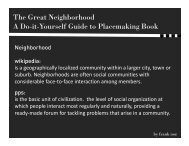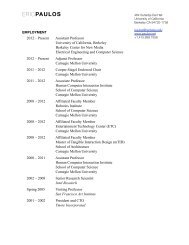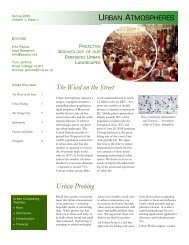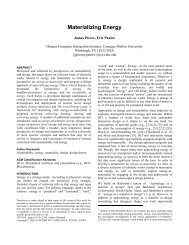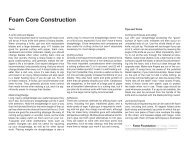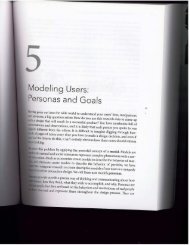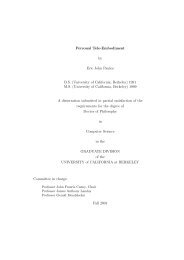Squishy circuits: a tangible medium for electronics education
Squishy circuits: a tangible medium for electronics education
Squishy circuits: a tangible medium for electronics education
Create successful ePaper yourself
Turn your PDF publications into a flip-book with our unique Google optimized e-Paper software.
CHI 2010: Work-in-Progress (Spotlight on Posters Days 3 & 4)April 14–15, 2010, Atlanta, GA, USA<strong>Squishy</strong> Circuits: A Tangible Medium<strong>for</strong> Electronics EducationSamuel JohnsonUniversity of St. Thomas2115 Summit Avenue, MailOSS101St. Paul, MN 55105John7491@stthomas.eduAnnMarie ThomasUniversity of St. Thomas2115 Summit Avenue, MailOSS101St. Paul, MN 55105apthomas@stthomas.eduAbstractThis paper reports on the design of a circuit buildingactivity intended <strong>for</strong> children, which replaces wires withmalleable conductive and non-conductive dough. Byeliminating the need <strong>for</strong> soldering or breadboards, itbecomes possible to very quickly incorporatemovement and light into sculptures, and to introducesimple circuit concepts to children at a younger age.Future applications in both structured and unstructuredlearning environments, based on results from apreliminary pilot study, are presented.KeywordsChildren, <strong>electronics</strong>, play dough, <strong>tangible</strong> interfaceACM Classification KeywordsH5.m. In<strong>for</strong>mation interfaces and presentation:Miscellaneous.General TermsTheory, ExperimentationCopyright is held by the author/owner(s).CHI 2010, April 10–15, 2010, Atlanta, Georgia, USA.ACM 978-1-60558-930-5/10/04.IntroductionThe inclusion of play in the learning process hasrepeatedly been shown to be an effective method.Exciting learning experiences can occur when childrenare engaged with materials, not just through simpleinteraction, but through designing, creating, andinventing [8]. Development of these creative thinking4099
CHI 2010: Work-in-Progress (Spotlight on Posters Days 3 & 4)April 14–15, 2010, Atlanta, GA, USA<strong>for</strong> resistance measurement is shown in Figure 1 (withthree different tube lengths shown). From theseexaminations, we were able to develop our own recipethat has a fairly consistent, stable, and predictable levelof electrical resistance. Figure 2 shows theapproximate resistance of commercial dough and theaverage, stabilized resistance <strong>for</strong> our developedsubstances <strong>for</strong> a small cylinder 10 cm in length.insulator was a “quick fix” <strong>for</strong> this problem, but lackedelegance and malleability. It was clear that it would bedesirable to have a non-conductive molding compoundas well.Insulating Molding CompoundThe use of insulating molding compound is a fun,builder friendly, and aesthetically pleasing method toinsulate the “wires” of squishy <strong>circuits</strong>. Figure 3(b)shows a circuit identical to the one in Figure 3(a), butwith a high resistance dough replacing the plastic wrap.Figure 4 shows a slightly more complex conductivesculpture, in which the red and green doughs areconductive, and the white dough acts as an insulator.Figure 2. Figure displays a graph <strong>for</strong> the electrical resistanceof commercially available molding compound, as well as ourconductive and insulating compounds.Making CircuitsAfter developing the recipe <strong>for</strong> conductive moldingcompound, we put our dough to use and startedbuilding simple <strong>circuits</strong>. These squishy circuit designsconsisted of: the conductive molding compound, a sixvolt DC power supply (We used four AA batteries insideof a plastic housing.), light emitting diodes (LEDs), andgearless DC motors. The left image in Figure 3(a)shows a simple LED circuit using the conductive dough.As the dough is essentially a wire, care needed to betaken not to short the circuit. Using plastic wrap as anFigure 3. <strong>Squishy</strong> LED <strong>circuits</strong>: (a) A circuit using plastic wrapas insulation, and (b) a circuit using non-conductive dough(white) as insulationThe ionic properties of most playdoughs made itchallenging to develop a compound with a high enoughelectrical resistance to insulate our squishy <strong>circuits</strong>. Theconductive substance is salt-based, uses tap water, andcontains additional ingredients that are ionic in aqueoussolution. Thus, simple modifications to compound’srecipe wouldn’t yield an extremely high resistance. Toachieve a resistance high enough <strong>for</strong> the compound toact as an insulator, a change in the total structure of4101
CHI 2010: Work-in-Progress (Spotlight on Posters Days 3 & 4)April 14–15, 2010, Atlanta, GA, USAthe substance was required. Our solution was foundwith an original, sugar-based, recipe including the useof deionized water.beginning <strong>electronics</strong> and programming curriculum. Asan introduction to these subjects, students usedconductive fabrics in conjunction with Buechley’sLilypad Arduino microprocessor. Her trials revealedthat the implementation of e-textiles increasedstudents’ test scores significantly. In separate trials,average test scores <strong>for</strong> <strong>circuits</strong> increased by 55percent, and basic programming scores increased by140 percent [2].Figure 4. Figure shows a complex sculpture that incorporatesmultiple LEDs and both dough compounds.The high resistance dough not only insulates theconductive dough, but also resists mixing with it. Thisis a vital property <strong>for</strong> insulating dough, as without thisproperty conductive molding compounds would be verysimilar to colorful play clays. If a dab of blue mixeswith white clay, the white clay is ruined, and will<strong>for</strong>ever be a non-white shade of blue. Without a nonmixingproperty the insulating compound could receivea dab of conductivity. This risks causing short circuit orreducing the effectiveness by reducing the conductivityof the conductive dough, or lowering the resistance ofthe insulating dough. Having a resistance too low toinsulate, and too high to conduct efficiently, the doughwould be less useful <strong>for</strong> circuit building, unless it was toserve the role of a resistor.ImplicationsWe believe that there are some exciting potential uses<strong>for</strong> this “squishy circuit” method. Research by Buechleyhas shown the benefits of incorporating e-textiles intoThe effects of playful learning are likely the mainsource <strong>for</strong> these increases. Playful learning and<strong>tangible</strong> <strong>medium</strong>s have been shown provide motivationto learn. Students are most involved in learning a topicwhen it intrigues their own personal interests. Whenstudents care about their work, they develop aprofound understanding of their subject matter [8].Research has shown a disconnect, between scientificdirection presented in classrooms and students’ pursuitof science on their own. By late elementary schoolmany students do not see their ef<strong>for</strong>ts outside of theclassroom as “science” at all [4]. Playful learningthrough <strong>tangible</strong> <strong>medium</strong>s bridges this gap bycombining what students learn, and what they do <strong>for</strong>fun. This deeper level of interest presentsunprecedented benefits to their learning process.Student interest can also be sparked by using familiarobjects in unfamiliar ways. Playful Invention andExploration workshops have show that, as studentsplayed with familiar materials, they were morecom<strong>for</strong>table experimenting and exploring.Simultaneously, they became more intrigued whensomething unexpected happened [8].Using squishy <strong>circuits</strong> has the potential to bring playfullearning methodologies to <strong>electronics</strong> <strong>education</strong>.4102
CHI 2010: Work-in-Progress (Spotlight on Posters Days 3 & 4)April 14–15, 2010, Atlanta, GA, USABuilding <strong>circuits</strong> with the conductive and nonconductivedough, as well as various <strong>electronics</strong>components, gives students a personal experience,because they are designing their own implementations.Furthermore, this method takes advantage of using afamiliar object, playdough, in an unusually unfamiliarway.In addition to the <strong>education</strong>al benefits mentionedabove, there are many physical benefits to usingsquishy <strong>circuits</strong>. The most important is safety. All ofour developed molding compounds are water solubleand nontoxic, an imperative characteristic that allplaydough must contain. These compounds are highlyeconomical as well. The recipes include inexpensiveingredients that anybody can easily make at home.Moreover, the compounds are reusable and possesslong life spans. Lastly, these compounds haveextremely low entry barriers; anyone can learn from,and enjoy them. The procedures <strong>for</strong> implementingbasic <strong>circuits</strong> are very simple as well. As no soldering,or even bread boards are needed, one can almostimmediately start building <strong>circuits</strong>.PilotOur pilot testing <strong>for</strong> the use of squishy <strong>circuits</strong>consisted of 11 students participating in a week-longsummer course on toy design. One lesson was devotedto teaching <strong>electronics</strong> through the use of squishy<strong>circuits</strong>. Students were taught using a lab-onlyexercise. The purpose of this was to determine if selfguidedsquishy circuit exploration, using no <strong>for</strong>mallecture but rather a short packet of “getting started”suggestions <strong>for</strong> the students, were an effective tool <strong>for</strong>teaching the beginning concepts of basic <strong>electronics</strong>.Be<strong>for</strong>e commencing the lab activity, all students took apreliminary test to determine how much existingknowledge they had regarding basic electronicconcepts. After the lab activity, the students weregiven the same test again. Evaluating these two testsin a student-by-student manner suggested that eachgained general improvement in their knowledge about<strong>circuits</strong> and electricity. This learning tool was especiallyeffective among students that, judging from thepreliminary test, had almost no pre-existing knowledgeof these subjects.Playful learning was also present during the pilot trial.Observations of the students during the pilot canstrongly imply that they were having fun while learning,something which definitely contributed to their overallexperience and understanding.Figure 5. <strong>Squishy</strong> circuit sculptures made by middle schoolstudents.As this pilot was done prior to the completion of theinsulating dough, the students were only usingconductive dough. We will be bringing the new squishycircuit kits, including both conductive and4103
CHI 2010: Work-in-Progress (Spotlight on Posters Days 3 & 4)April 14–15, 2010, Atlanta, GA, USAnonconductive dough to classrooms <strong>for</strong> more testingover the coming year.Future WorkThis paper presents the initial steps in the explorationof dough-based squishy <strong>circuits</strong> as an <strong>education</strong>al toy.There are a number of improvements that we feel canbe made. Oxidation was a problem over extended useas rust <strong>for</strong>med on LED leads. Further research coulddevelop modified electronic components, specific tosquishy <strong>circuits</strong> that have longer life spans and betterusability. Continued research in squishy <strong>circuits</strong> couldalso develop squishy resistors. Through intenseexamination of ingredients and their quantities, a“resistance <strong>for</strong>mula” could be established to yieldmolding compounds with controllable and preciseelectrical resistances.Another, more playful, continued research topicincludes squishy robots. Implementing amicroprocessor board with the squishy <strong>circuits</strong> could bean innovative way to teach robotics and programmingas well as basic <strong>electronics</strong>. The resistance of a specificpiece of molding compound is directly correlated to thatpiece’s shape, so speakers to these <strong>circuits</strong> could be aninteresting way to manipulate sound. Students couldexamine volume and tonal changes in a speakerrelative to the shapes and lengths of their designs.They could even potentially change the soundproperties as it’s playing by stretching and squishingthe circuit.AcknowledgementsWe are grateful to our pilot study participants <strong>for</strong> theirfeedback and enthusiasm.Citations1. Brown, J.R. Visual Learning <strong>for</strong> Science andEngineering. A Visual Learning Campfire. 2002.http://<strong>education</strong>.siggraph.org/conferences/other/visual-learning.2. Buechley, L., Eisenberg, M., Elumeze, N. Towards aCurriculum <strong>for</strong> Electronic Textiles in the High SchoolClassroom. Proc. ITiCSE. 2007.3. Buechley, L., Hendrix, S., Eisenberg, M. Paints,Paper, and Programs: First Steps Toward theComputational Sketchbook. Proc. TEI. 2009.4. Herrenkohl, L.R. Supporting Young Children’s EarlyLearning in Science. Conference on Early Learning.2007.5. Jones, B. Resistance Measurements in Play-Doh. ThePhysics Teacher 31:1 (1993). 48-49.6. Physics 112: General Physics II Lab Manual.Spelman College. 2006. 10-11.http://www.spelman.edu/academics/programs/physics/physics112labmanual2006.pdf.7. Resistivity and Play-Doh.http://www.physics.udel.edu/~watson/scen103/colloq2000/problems/playdohexpt.html.8. Resnick, M. Computer as Paintbrush: Technology,Play, and the Creative Society. In Singer, D.,Golikoff, R., and Hirsh-Pasek, K. (eds.), Play =Learning: How play motivates and enhanceschildren’s cognitive and social-emotional growth,Ox<strong>for</strong>d University Press (2006).We believe that squishy <strong>circuits</strong> have the potential tobe used in numerous ways, and help students canacquire richer and more personal connections tosubject knowledge.4104




